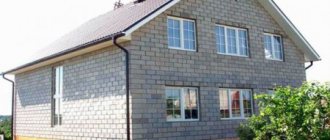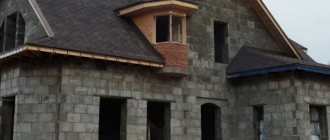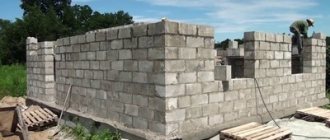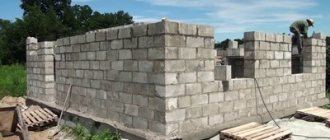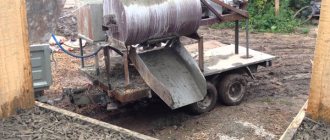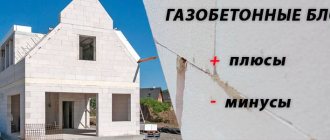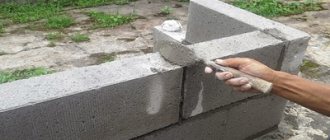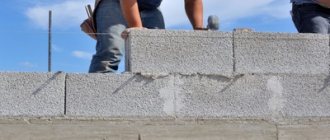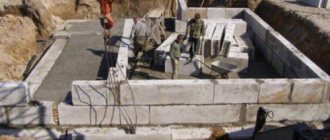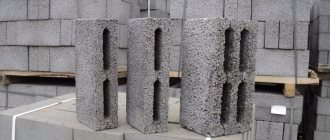As technological progress moves forward, more and more new materials appear for building houses with your own hands. If earlier it was limited to wood, stone or brick, today there are various types of concrete that are superior to other materials in terms of characteristics. One of these materials is wood concrete. This is a unique material that combines the advantages of both concrete and wood. Its composition is quite simple, and you can prepare the solution yourself. It is noteworthy that it can be used like ordinary concrete, by pouring the mixture into formwork, or it can be made in the form of blocks for ordinary masonry. Arbolite blocks can be bought in a specialized store, or you can prepare the solution yourself by making blocks from the finished mixture.
All you need is to know the exact composition of wood concrete, the proportions for mixing the mixture and the technology for its preparation. Let's take a closer look.
Arbolite block - what does it consist of?
The wood concrete from which wood concrete blocks are formed for masonry consists of 3 main components:
- aggregate;
- mineral binder;
- chemical additives and water.
By combining all these elements, an arbolite mortar is obtained, which is subsequently used to form blocks. The composition is quite simple and everyone can make the material for their own purposes. The material itself is light, so the blocks are ideal for the tub. Their advantage, compared to gas blocks and foam blocks, is their greater strength limit. They are resistant to cracks and impacts.
Despite the fact that the main component is sawdust (chips), wood concrete is highly valued and is not inferior in characteristics to traditional materials. On the contrary, wood concrete blocks retain heat well and create a good indoor microclimate.
Difficulties in work and possible errors
To avoid the formation of cold bridges, you need to choose blocks that are made strictly in accordance with GOST. The deviation from the set values should be a maximum of 5 mm. A poorly made block can shrink over time, which can lead to curvature and deformation of the wall surface.
Arbolite blocks
cannot be treated or insulated with a vapor-proof material or tiles placed on top of them, otherwise the moisture coming from inside the house will try to escape through the walls to the outside, but will not be able to.
The result is the accumulation of moisture in the elements, the formation of mold and mildew.
The base should not be filled with cellular concrete , otherwise dampness and moisture will penetrate through it into the walls.
If the work is done independently, then due to lack of experience, you can lay out the walls crookedly and fail to maintain the distance between the blocks. And this will lead to loss of appearance of the masonry.
Before installing the roof, it is important to make an armored belt over the last row , otherwise the load on the walls will not be evenly distributed, and the blocks will begin to deform.
Organic filler
The lion's share in the composition of wood concrete blocks is occupied by wood chips. This is the main material that is included in its composition. Such organic filler can be easily purchased for little money. It is worth contacting a local sawmill where there is wood processing waste and negotiate with the workers. Coniferous trees and hardwoods are mainly used. Fir, pine, spruce, aspen, beech, birch and poplar are ideal for making wood concrete mortar. You can also use flax fire.
The most commonly used wood filler is: crushed wood, shavings with sawdust, in a ratio of 1:1 or 1:2, wood chips, shavings and sawdust, in a ratio of 1:1:1. All proportions are measured in volume. For example, if you need to achieve a ratio of 1:2, then take 1 bucket of sawdust and 2 buckets of shavings. Sawdust can be easily replaced with flax or hemp stems; this will not affect the composition.
What are the requirements for the filler? First of all, it is important to choose the right size. It is not recommended to use large sawdust, because when the products come into contact with water, they may increase in volume. As a result, the block may collapse. If you use particles that are too small, the consumption of the cement mixture increases. The recommended particle size is 15 or 25 mm long and no more than 2–5 mm wide. Raw materials should not have leaves or other impurities.
Warning! Larch and freshly cut wood of any species are not added to the composition of arbolite solutions. It is forbidden!
Bonfire flax
A complete filler added to the solution is flax flax. Since it contains sugar, chemical additives must be used. To improve the quality of the finished mixture for blocks, the fire is pre-treated with limestone milk, in the proportion: 200 kg of fire per 50 kg of lime. Then everything is kept in a pile for several days, after which everything is ready for the production of wood concrete. Thanks to this technology, cement consumption is significantly reduced. 1 m3 of wood concrete requires 50–100 kg of cement.
Important! If flax bonfire is used in its usual form, then hemp stems require some processing. They must first be crushed.
Due to the fact that organic waste contains water-soluble substances, including resin acids and sugar, this prevents good adhesion between particles. To remove sugar, wood chips must be exposed to air for 3 months or more, or treated with limestone. In the second case, the mixture is aged for 3–4 days. The contents are mixed 2 times a day.
Mineral binder
There is no way you can make a solution with your own hands without a binder. It makes wood concrete blocks durable and suitable for masonry. Portland cement grade M400, M500 or even higher is used as a binder.
Its consumption depends on the type of aggregate, particle size, cement brand, characteristics, etc. To get a little guidance, you can determine the consumption this way: factor 17 must be multiplied by the required brand of wood concrete. For example, you need to prepare a solution, grade 15 (B1). In this case, 1 m3 of wood concrete will require 255 kg of cement.
What you will need for construction: consumables and tools
In addition to the building material for the walls and the adhesive composition or cement-sand mortar that will be used to erect the structure, you will also need tools :
- building level;
- cord for installing plumb lines and beacons;
- spatula for applying glue;
- square;
- Master OK;
- drill with a nozzle for stirring glue;
- buckets - for water and for solution;
- ladle-trowel;
- chainsaw or hand saw, i.e. everything you can use to saw wood concrete blocks;
- roulette.
Using a building level and plumb lines, as well as beacons, the master checks the evenness of the masonry. For example, to lay out the first row, you need to pull the cord so that the stone is laid according to its line.
Then, using a building level, the evenness is checked again horizontally and vertically. To apply the glue, use a trowel or a wide spatula with teeth - it evenly distributes the mass over the stone. Using a square, they check the evenness of the corners, and a chainsaw is necessary so that you have something to cut the blocks with. A tape measure will also be useful, with which you can check the masonry diagram.
Small reinforcement mesh or metal reinforcement bars may also be useful. They are needed for reinforcing and strengthening walls.
Chemical additives
The properties of wood concrete blocks directly depend on chemical additives. Their use is mandatory in any case, no matter in what climate the work is performed. Thanks to additives, the filler can be used without aging, because they neutralize sugar and other substances, which improves the quality of the finished blocks.
Such additives can be used:
- liquid glass (sodium silicate). It closes all the pores in the wood, so moisture will not get inside. Used after removing sugar;
- slaked lime. It breaks down sugar and kills microorganisms in sawdust;
- aluminum sulfate. Excellent at breaking down sugar. Thanks to the component, the composition gains strength faster;
- calcium chloride. Kills all microorganisms and gives wood anti-rot properties.
Aluminum sulfate and calcium chloride are considered the best additives. The proportions of additives are 2–4% by weight of cement, or from 6 to 12 kg per 1 m3. Additives can be combined with each other.
Proportions for arbolite blocks
To make wood concrete blocks with your own hands, it is important to know not only the composition, but also the proportions. The ratio of all components to each other is as follows: 4: 3: 3 (water, wood chips, cement). Chemical additives – 2–4% of the total mass.
To make 1 m3 of wood concrete with your own hands, from which masonry blocks will be made, you will need:
- 300 kg of wood waste;
- 300 kg of Portland cement;
- 400 liters of water.
Calcium chloride or another chemical is added to the solution. This is a classic composition that you can easily make with your own hands. All you need: a concrete mixer or a large container for mixing, buckets, shovels, forks (for mixing by hand) and all wood concrete components. The work process is as follows:
- The filler (chips) is poured into a container and moistened with water. Then the adhesion to cement will be better.
- Then, cement with additives is gradually added. The contents are thoroughly mixed in a concrete mixer or with your own hands using a pitchfork.
- Now is the time to add water in which the chemical additives are already dissolved. Everything gets mixed up again.
- Both cement and water need to be added not immediately, but little by little, in small portions. This will make the mixture easier to mix and the components will be better connected to each other.
- After the solution is made, it must be placed in prepared molds so that they take on the appearance of masonry blocks.
This is the composition and proportions of a mixture of wood concrete blocks that you can make with your own hands. All that is required is to be careful and strictly follow the instructions for its preparation. Below is a table that will help you understand what brands of wood concrete are available and what are the proportions of the components for its preparation.
Step-by-step instruction
Laying wood concrete blocks is similar to laying bricks, aerated concrete or cinder blocks. But since blocks can absorb moisture, it is important to protect the wall from excess moisture from the first row .
Laying the first row
- To protect the blocks from high humidity, you need to waterproof the foundation or basement. The waterproofing layer can be roofing material (2 layers) and bitumen mastic or liquid rubber.
- Before applying the adhesive solution, you need to decide on the number of blocks that will be needed per row. To do this, the elements are laid out along the entire length of the wall, and the blocks are trimmed in advance where necessary.
- Using a spatula or trowel, apply glue approximately 5-6 mm thick. After laying the block and pressing it, the glue will pass into the cavity of the block between the chips and as a result the seam will be about 2-3 mm.
- Next, the first element from the corner is laid strictly according to the level or square. If the block was placed crookedly, then it is corrected using a rubber hammer. An ordinary metal hammer cannot be used, otherwise it will damage the integrity of the product, leaving dents in it.
- Using exactly the same scheme, you need to install one block at all corners of the building, and stretch the fishing line between them. This will help you have the correct reference point when laying blocks between the two corners of the wall.
- The side of the corner block is coated with an adhesive solution, and the next element is pressed tightly against it. And so on until the end, until the entire first row is laid.
Subsequent rows
After laying the starting row, you need to wait about 5 hours until the adhesive solution sets.
Next, checking the level, the remaining rows are laid out - sequentially block by block, in a checkerboard pattern in relation to the previous row.- After the first row, you must put a reinforcing mesh.
- The solution is applied along the edges of the block below.
Due to this, an air thermal break is formed inside. It is needed to compensate for the high thermal conductivity that wood concrete has. To create a gap in the masonry seam, you can also use polystyrene foam tape, wooden slats and other separators that will eliminate the possibility of cold bridges.
When laying blocks, it is important to maintain the same distance between them. The maximum thickness of the seam should not exceed 3 cm .
This is worth knowing : for buildings with one floor, the recommended wall thickness is 30 cm; if the house has more than 2 floors, then the optimal thickness is 40 cm. A thickness of 20 cm is allowed, provided that the wall is additionally lined with brick, or insulate inside and outside.
In one day, you are allowed to lay out no more than 3 rows , not counting the starting one. Then work is stopped for a day to allow the solution to dry and gain strength. If you add additives to the mixture that increase the rate of setting of the solution and strength gain, then work can begin a little earlier than in a day.
After laying the 4th row, it is important to mark future window openings so as not to accidentally block them.
Wall reinforcement
To impart rigidity to the future structure, wood concrete walls need to be strengthened . It is not necessary to use reinforcement bars for this. An ordinary polymer or metal reinforcing mesh is suitable for this purpose. It needs to be laid out on the surface every 3-5 rows.
